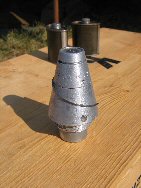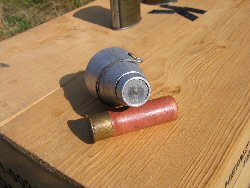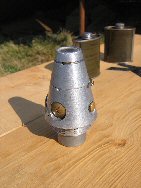Fuze, M53
This article is from TM 9-1904 which is available on this site.
The contents have been supplemented with modern photos and comments or additional information added in some instances.
Date Compiled: 7/17/2007
Editor: Chris Guska
Point-detonating Faze M53.
Description . The M53 Fuse is a delay fuse used to effect the functioning of rounds fired from the 81-mm trench mortar. It is normally used with heavy shell where penetration is desired. This fuse will fit any of the "M" series of shell; however, it is only authorized to be assembled in the H.E. Shell M56 for 81-mm mortars. The weight of the fuse is 0.45 pound.
The fuse housing is made of aluminum. The head of the fuse screws into the fuse body. The head houses a comparatively short striker which is flush with the nose of the fuse. The striker is held in place by a shear wire. The head is internally threaded at the base to receive a delay assembly. The delay assembly houses a primer, delay pellet of black powder and a relay of lead azide. The body houses the slider, slider lock, safety pin, and set-back pin, with their respective springs. In the center and at the base of the body is an inverted brass cup known as a lead cup. It is held in place by crimping and contains a tetryl lead pellet. The base of the body is internally threaded to receive a booster cup which in turn houses a tetryl booster pellet.
Safety features. The safety features correspond to the M45 and M52 P.D. Fuses previously described. The M53 is bore safe. This is accomplished by the assembling of the detonator into a slider which in the unarmed position holds the detonator out of alignment with the relay charge of lead azide and the lead charge of tetryl. Arming of the slider within the bore of the weapon is prevented by the safety pin, the head of which bears against the bore, thereby retaining the slider in the unarmed position. A set-back pin is used to hold the safety pin in position until set-back action occurs. To prevent arming of the set-back pin, a cotter pin (safety wire in later manufacture) is utilized, preventing the set-back pin from moving rearward against its spring during handling.
90th IDPG Weapons





